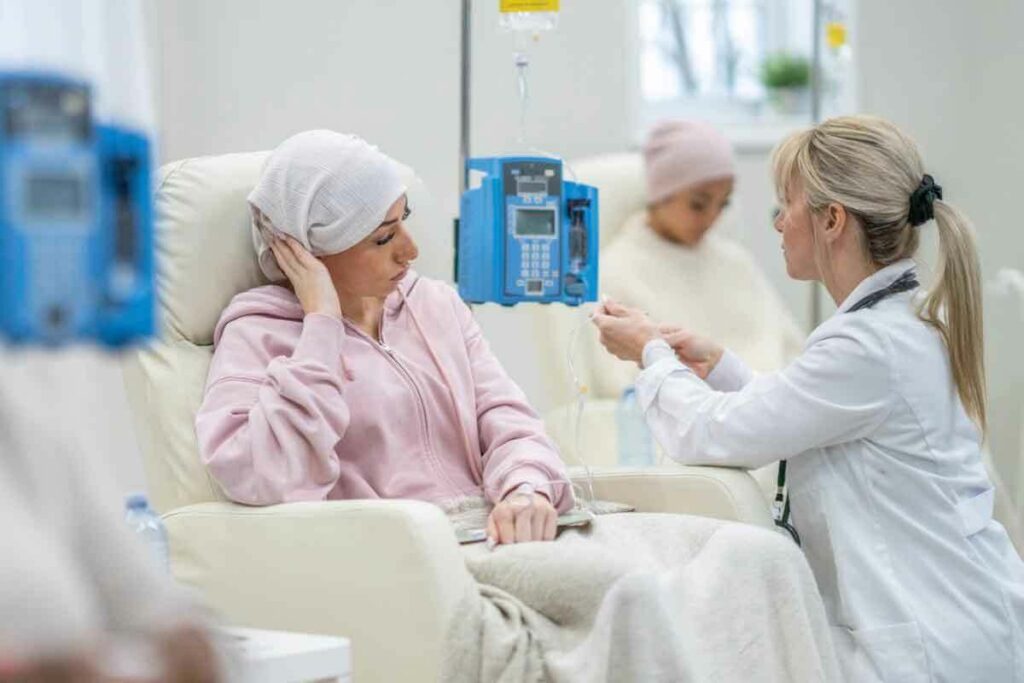
Types of blood cancers (or hematologic cancers) affect the blood, bone marrow, and lymphatic system. These include various kinds such as leukemia, lymphoma, myeloma, myelodysplastic syndromes (MDS), and myeloproliferative neoplasms (MPN), each with distinct characteristics and treatment approaches.
In the U.S., about 1,698,339 people live with or have beaten leukemia, lymphoma, myeloma, myelodysplastic syndromes (MDS), or myeloproliferative neoplasms (MPNs). Knowing the types of blood cancers is key for good treatment.
At LivHospital, we help you understand the seven major blood cancer names. We aim to make the complex world of blood cancers clearer and more manageable.

Blood cancers, also known as hematologic malignancies, affect the blood, bone marrow, and lymph nodes. They disrupt the normal production of blood cells, causing health problems.
Blood cancers start in the bone marrow or lymphatic system. This is where blood cells are made. The main types are leukemia, lymphoma, and myeloma.
These cancers can harm different parts of the blood system. This includes the bone marrow, blood cells, lymph nodes, and more.
The growth of abnormal blood cells is what causes blood cancers. This can lead to anemia, infections, and bleeding problems. Knowing how blood cancers start and what they are is key to treating them.
Hematologic malignancies have some common traits. They involve the abnormal growth of blood cells and disrupt normal blood cell production. These cancers can be aggressive or slow-growing, with different symptoms and treatments.
Some common traits include:
Understanding these traits helps us know the different types of blood cancers and how they affect the body.

It’s important to know about the different blood cancers to diagnose and treat them. Blood cancers affect the blood, bone marrow, and lymphatic system. They are complex, so we need a clear way to classify them.
Blood cancers are divided into several main types. These are based on where the cancer starts and its characteristics. The seven main types are:
Each type has its own signs and needs a specific treatment plan. Getting the right diagnosis is key to choosing the best treatment.
Each blood cancer type has its own way of working. Leukemia makes too many blood cells in the bone marrow. This stops normal blood production.
Multiple myeloma makes too many plasma cells in the bone marrow. This leads to too much of a certain protein in the blood. Myelodysplastic syndromes (MDS) and myeloproliferative neoplasms (MPNs) affect the bone marrow too. MDS means the bone marrow doesn’t work well, and MPNs mean it makes too many blood cells.
Knowing how each cancer works helps doctors find better treatments. By understanding each cancer’s unique traits, doctors can create treatment plans that work best for each patient.
Leukemia is a cancer that affects the blood and bone marrow. It’s not just one disease but many. In the U.S., about 57,049 people live with leukemia. We’ll look at the four main types: Acute Myeloid Leukemia (AML), Acute Lymphoblastic Leukemia (ALL), Chronic Myeloid Leukemia (CML), and Chronic Lymphocytic Leukemia (CLL).
AML is a fast-growing leukemia that starts in the bone marrow. It quickly moves into the blood. It can spread to other parts, like the lymph nodes and liver. Treatment for AML often involves intensive chemotherapy, and sometimes a bone marrow transplant is needed.
ALL is when there’s too many immature white blood cells. This type of leukemia grows fast if not treated. ALL is the most common leukemia in kids, but it also happens in adults. Treatment usually includes chemotherapy and sometimes a stem cell transplant.
CML grows slowly and often doesn’t show symptoms at first. It makes too many granulocytes, a type of white blood cell. CML is linked to a genetic change called the Philadelphia chromosome. New treatments, like tyrosine kinase inhibitors, have changed how we treat CML.
CLL makes too many lymphocytes in the bone marrow. It mostly affects older adults and may not show symptoms for years. CLL is considered incurable with current treatments, but we can manage it with various therapies, including targeted therapy and chemotherapy.
Leukemia is not just one disease but many. Each type needs its own treatment plan. Knowing the differences between AML, ALL, CML, and CLL is key to effective treatment.
“The classification of leukemia into different types is critical for choosing the right treatment.”
By understanding each type of leukemia, doctors can give more personalized care. This can lead to better outcomes for patients.
Leukemia is a type of blood cancer, but not all blood cancers are leukemia. This shows a key difference. Blood cancer, or hematologic cancer, includes many cancers that affect the blood, bone marrow, and lymphatic system.
To clear up some common misunderstandings about blood cancer.
Many people think blood cancer and leukemia are the same. But, leukemia is just one type of blood cancer. “The terms are not interchangeable, as blood cancer is a broader term that includes several types of malignancies.”
Leukemia is the twelfth most common cancer in the UK. Over 9,900 new cases are diagnosed every year. This shows how important it is to know the different types of blood cancers.
Leukemia is when white blood cells grow too much in the bone marrow. It has several types, like Acute Myeloid Leukemia (AML) and Acute Lymphoblastic Leukemia (ALL).
Other blood cancers include lymphoma, multiple myeloma, and myelodysplastic syndromes. Each has its own unique features and symptoms.
A key quote from a medical expert states:
“Understanding the specific type of blood cancer is key for the right treatment and better patient outcomes.”
In summary, while leukemia is a major blood cancer, it’s not the only one. Knowing the differences between blood cancers is vital for correct diagnosis and treatment.
Lymphoma is a term for cancers of the lymphatic system. This includes Hodgkin and non-Hodgkin lymphoma. The lymphatic system fights infections and diseases. When lymphoma occurs, it can harm the system’s function, causing health problems.
Lymphoma is a major blood cancer with different types. In the U.S., about 50,202 people live with Hodgkin lymphoma. It’s key to know about this condition.
Hodgkin lymphoma has Reed-Sternberg cells in lymph nodes. Symptoms include:
These symptoms can be like other illnesses. A biopsy is needed to confirm Hodgkin lymphoma.
Non-Hodgkin lymphoma has over 60 subtypes without Reed-Sternberg cells. Common types are:
It can start in lymph nodes, spleen, or lymphoid tissues. Knowing the subtype helps find the right treatment.
We aim to give full care and support for lymphoma patients. We meet their unique needs and situations.
Multiple myeloma is a blood cancer where bad plasma cells grow in the bone marrow. This messes up the bone marrow’s job, causing health problems.
Multiple myeloma makes the bone marrow produce too many plasma cells. These bad cells push out healthy cells. This makes it hard for the body to fight off infections and keep bones strong.
The bones suffer a lot, too. Multiple myeloma can cause:
Bone damage happens because the cancerous plasma cells mess with bone repair. This makes bones weak.
Doctors use several tests to find multiple myeloma:
Staging multiple myeloma is key for knowing how serious it is and what treatment to use. The Revised International Staging System (R-ISS) is often used. It looks at serum albumin, beta-2 microglobulin, and chromosomal changes.
Knowing the stage helps doctors make treatment plans that fit each patient. This can make treatment better and improve life quality.
Myelodysplastic syndromes (MDS) are a group of blood disorders that can turn into acute leukemia. About 1,097 people in the U.S. live with MDS. We need to know more about it. We’ll look into MDS’s types, how it’s classified, and what makes it progress to acute leukemia.
MDS makes it hard for the body to make blood cells. This leads to many problems. The World Health Organization (WHO) helps sort MDS into subtypes. They look at the bone marrow’s blasts and genetic changes.
Many things can make MDS worse and turn it into acute leukemia. These include chemicals, radiation, and genetic changes. Knowing these risks helps catch MDS early. This can stop it from getting worse.
Early detection and management are key for better MDS outcomes. Healthcare providers can use this knowledge to create better treatment plans. This helps manage MDS more effectively.
Myeloproliferative neoplasms (MPN) are a group of blood disorders. They are caused by too many blood cells being made. These rare blood cancers can really affect a person’s life.
About 5,442 people in the U.S. live with MPNs. This shows how important it is to know about these conditions and how to manage them.
MPNs are mainly split into three types: primary myelofibrosis, polycythemia vera, and essential thrombocythemia. Each type has its own signs and risks.
The symptoms of MPNs can differ based on the type. They often include tiredness, weight loss, and a big spleen. Treatment plans are made for each type. They might include medicines to lower blood cell counts and ease symptoms.
“The main goal of treatment is to manage symptoms and lower the risk of MPN complications,” say hematology experts.
It’s key to understand MPNs to give the right care and support. Knowing the types helps doctors create better treatment plans.
Hairy cell leukemia and Waldenstrom macroglobulinemia are rare blood cancers. They have unique features and treatment methods. These cancers belong to a group of diseases that affect the blood and bone marrow.
Hairy cell leukemia is a slow-growing cancer of the blood. It happens when the bone marrow makes too many B cells. This leads to fewer healthy blood cells.
The cancer cells look like hairs under a microscope. This is why they are called “hairy cell.”
Symptoms and Diagnosis: Symptoms include feeling tired, getting sick easily, and having an enlarged spleen. Doctors use blood tests and bone marrow biopsies to diagnose it.
Treatment Options: Treatments include chemotherapy, targeted therapy, or immunotherapy. Sometimes, doctors just watch and wait if the patient feels okay.
Waldenstrom macroglobulinemia is a rare lymphoma. It causes the blood to thicken because of too much IgM antibody. This can lead to many problems.
It’s important to know about these rare blood cancers to help patients. Medical research is always looking for new ways to help those with hairy cell leukemia and Waldenstrom macroglobulinemia.
To find out if someone has blood cancer, doctors use many tools. They look at lymphoma cells and blasts to make a diagnosis. Getting the right diagnosis is key for good treatment and care.
Blood tests are usually the first step in finding blood cancer. They show if there are too many or too few blood cells, which might mean cancer. A complete blood count (CBC) is a common test to check blood cell levels. If the CBC shows cancer, a bone marrow examination is done to confirm it.
A bone marrow examination takes a sample of bone marrow for analysis. This helps figure out what kind of cancer cells are there. It can tell the difference between lymphoma cells and blasts, which are young cells that might mean leukemia.
Imaging studies are also important in diagnosing and figuring out how far cancer has spread. Computed tomography (CT) scans, positron emission tomography (PET) scans, and magnetic resonance imaging (MRI) help see how much cancer is there.
Molecular testing is also key. It looks at the genes of cancer cells to find specific changes. This information helps doctors know how serious the cancer is and what treatment to use.
It’s important to know how different blood cancers look at a cellular level. Lymphoma cells are usually in the lymph nodes, while blasts are in the bone marrow and blood. Knowing these differences helps doctors diagnose and treat blood cancer right.
In summary, finding out if someone has blood cancer takes a lot of steps. Blood tests, bone marrow exams, imaging, and molecular tests are all used. By understanding the cells of different blood cancers, doctors can give accurate diagnoses and plan the best treatments.
We’ve looked at different blood cancers like leukemia, lymphoma, and multiple myeloma. Advances in research have greatly improved our understanding of these diseases. Studies now show how lymphoma cells and blasts differ, helping guide treatment choices.
These breakthroughs have brought new hope to patients everywhere. Ongoing research is key to better treatments and outcomes. By building on current research, we can make treatments more effective and save more lives.
We’re committed to top-notch healthcare, supporting research and caring for patients worldwide. Moving forward, staying ahead in blood cancer research and treatment is vital. This ensures patients get the best care possible.
Blood cancers are diseases that harm the blood, bone marrow, and lymphatic system. They include leukemia, lymphoma, and multiple myeloma.
No, they are not the same. Blood cancer is a wide term for many cancers, like leukemia. Leukemia is a specific blood cancer that affects the blood and bone marrow.
The main types are leukemia, lymphoma, multiple myeloma, myelodysplastic syndromes (MDS), and myeloproliferative neoplasms (MPN).
Lymphoma cells build up in the lymphatic system. Blasts are young white blood cells found in leukemia, like AML and ALL.
Doctors use blood tests, bone marrow exams, imaging, and molecular tests to diagnose blood cancers.
Symptoms vary by type but include fatigue, weight loss, fever, night sweats, and swollen lymph nodes.
Yes, there are four main types: acute myeloid leukemia (AML), acute lymphoblastic leukemia (ALL), chronic myeloid leukemia (CML), and chronic lymphocytic leukemia (CLL).
Multiple myeloma is a blood cancer that harms plasma cells in the bone marrow, causing bone damage and other issues.
MDS are pre-leukemic disorders with abnormal blood cell production in the bone marrow.
MPN are conditions with too many blood cells, including primary myelofibrosis, polycythemia vera, and essential thrombocythemia.
Rare blood cancers include hairy cell leukemia and Waldenstrom macroglobulinemia. They have unique symptoms and treatments.
Subscribe to our e-newsletter to stay informed about the latest innovations in the world of health and exclusive offers!
WhatsApp us